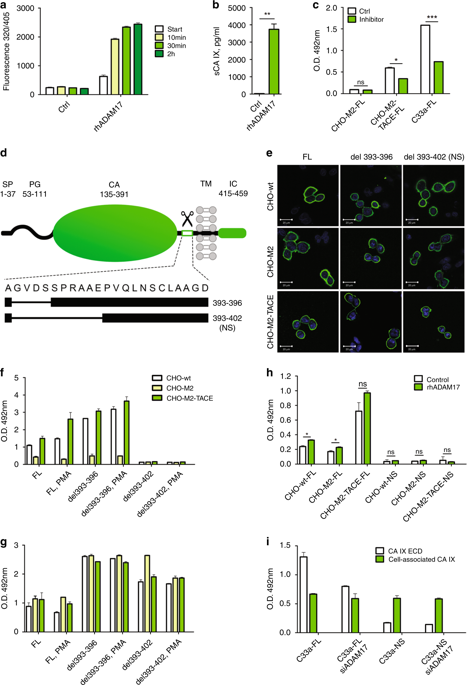British Journal of Cancer ( IF 6.4 ) Pub Date : 2020-03-25 , DOI: 10.1038/s41416-020-0804-z Ivana Kajanova 1 , Miriam Zatovicova 1 , Lenka Jelenska 1 , Olga Sedlakova 1 , Monika Barathova 1 , Lucia Csaderova 1 , Michaela Debreova 1 , Lubomira Lukacikova 1 , Katarina Grossmannova 1 , Martina Labudova 1 , Tereza Golias 1 , Eliska Svastova 1 , Andreas Ludwig 2 , Petr Muller 3 , Borivoj Vojtesek 3 , Jaromir Pastorek 1 , Silvia Pastorekova 1

|
Background
Carbonic anhydrase IX (CA IX) is a hypoxia-induced enzyme regulating tumour pH and facilitating cell migration/invasion. It is primarily expressed as a transmembrane cell-surface protein, but its ectodomain can be shed by ADAM17 to extracellular space. This study aims to elucidate the impact of CA IX shedding on cancer cells.
Methods
We generated a non-shed CA IX mutant by deletion of amino acids 393–402 from the stalk region and studied its phenotypic effects compared to full-length, shedding-competent CA IX using a range of assays based on immunodetection, confocal microscopy, in vitro real-time cell monitoring and in vivo tumour cell inoculation using xenografted NMRI and C57BL/6J female mice.
Results
We demonstrated that the impairment of shedding does not alter the ability of CA IX to bind ADAM17, internalise, form oligomers and regulate pH, but induces cancer-promoting changes in extracellular proteome. Moreover, it affects intrinsic properties of cells expressing the non-shed variant, in terms of their increased ability to migrate, generate primary tumours and form metastatic lesions in lungs.
Conclusions
Our results show that the ectodomain shedding controls pro-tumorigenic and pro-metastatic roles of the cell-associated CA IX and suggest that this phenomenon should be considered when developing CA IX-targeted therapeutic strategies.
中文翻译:

碳酸酐酶 IX 胞外域切割的损伤增强了癌细胞的致瘤性和转移性表型。
背景
碳酸酐酶 IX (CA IX) 是一种缺氧诱导的酶,可调节肿瘤 pH 值并促进细胞迁移/侵袭。它主要表达为跨膜细胞表面蛋白,但其胞外域可由 ADAM17 脱落到细胞外空间。本研究旨在阐明 CA IX 脱落对癌细胞的影响。
方法
我们通过从茎区域删除氨基酸 393-402 生成了一个非脱落的 CA IX 突变体,并使用一系列基于免疫检测、共聚焦显微镜的测定法研究了其与全长、脱落能力 CA IX 相比的表型效应,在使用异种移植的 NMRI 和 C57BL/6J 雌性小鼠进行体外实时细胞监测和体内肿瘤细胞接种。
结果
我们证明脱落的损伤不会改变 CA IX 结合 ADAM17、内化、形成寡聚体和调节 pH 的能力,但会诱导细胞外蛋白质组发生促癌变化。此外,它会影响表达非脱落变体的细胞的内在特性,即它们增加的迁移能力、产生原发性肿瘤和在肺部形成转移性病变的能力。
结论
我们的结果表明,胞外域脱落控制细胞相关 CA IX 的促肿瘤发生和促转移作用,并表明在开发 CA IX 靶向治疗策略时应考虑这种现象。











































 京公网安备 11010802027423号
京公网安备 11010802027423号